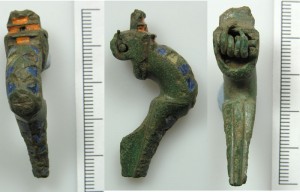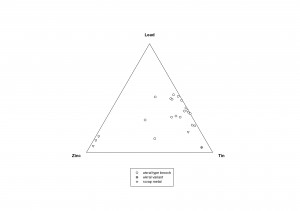This is a very exciting week for me as Matthew Ponting has analysed the first set of brooch samples and so we now have some results. He has sampled 19 brooches so far along with 4 fragments of what we think are mis-cast brooches (and were hoping were mis-cast Wirral brooches!) using Atomic Absorption Spectroscopy which allows the amount of each element in the alloy to be identified. The results so far are very encouraging for the project.
The aim of looking at the Wirral brooches more closely was to try and identify a possible location of manufacture through their distribution and the alloy composition analysis. What we hoped was that all the brooches would have the same alloy composition, suggesting that they were made in the same place or by the same person. Of the 19 brooches tested, 18 are similar enough to say they are all a leaded bronze and constitute a group. This is really good as it adds further weight to the thought that these were all made by one person/workshop (whether static or itinerant).
The one brooch which does not match is LVPL-059BC2. This has a very low lead content and cannot be said to be within the same group as the other 18. At first this could be a problem as it means not all the brooches are fitting the pattern. However Matthew and I then took the brooch out of the box and saw it was a variant! This was cause for many smiles and relieved sighs. Our idea is still on course. The only brooch so far with a different alloy composition is one which stylistically is not a typical Wirral brooch. The picture below shows that it shares some characeteristics with a typical Wirral brooch (stepped head, strong profile, small boss on the knee) but that it also has some different characteristics- mainly the bow decoration which is triangular as opposed to the usual linear panels.

The 4 waste fragments which were tested were a different composition again and so suggest that something completely different was being made on this site, not the Wirral brooches, even though Wirral brooches have been found in the same field as these waste pieces. Below is a diagram which Matthew created to show the results of the testing on one page with all 3 groups showing (typical Wirral, the variant and the 4 fragments). It is based on the formula Bayley and Butcher used when they tested the thousands of Roman brooches from Richborough and is a great way to easily and quickly be able to see groupings.
